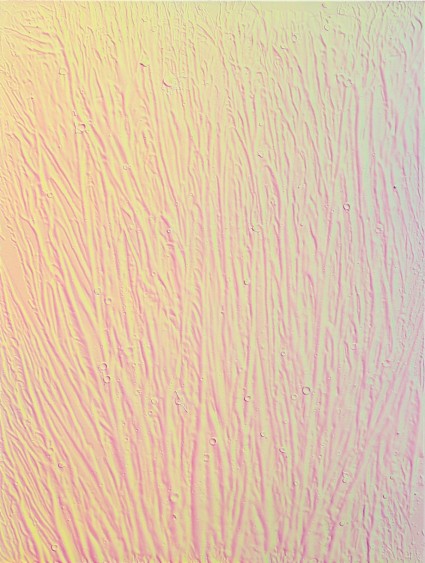DJ Pangburn, The Creators Project (VICE), July 7, 2014

Michael Staniak, IMG_885 (holographic), 2014
Last fall in New York City, Paddles ON! launched as the first auction dedicated solely to digital art at a major international auction house. Organized and curated by former Eyebeam Curatorial Fellow and 319 Scholes director Lindsay Howard, it was a smashing success by commercial digital art standards; some 500 people attended the auction held at Phillips’ New York headquarters, and snapped up 92% of the works by value and 80% by lot. It was a unique moment wherein the ever-nascent digital art community collided with the established and commodity-driven contemporary art world.
On July 3rd, in collaboration with Phillips’ Megan Newcome, and Annie Werner of Tumblr, Howard brought Paddles ON! to London in what was the United Kingdom’s first ever formal auction for digital art. According to Paddles ON!, artists and galleries received 100% of the auction profits, while a portion of the buyer’s premiums are to be donated to Opening Times, a new not-for-profit online commissioning body.
“Digital art is a true reflection of the contemporary age,” said Howard. “3D printed self-portraits to architectural renderings in Google Earth, from digital paintings to artworks composed by algorithms, the artists examine the ways in which experience is now thoroughly shaped by digital technologies.”
Held at Phillips’ London auction house, 23 works by 23 artists, many of which originated on Tumblr’s distinctly digital realm of image-based blogs, were shown, estimated to be worth a combined total somewhere in the vicinity between £53,600 ($90,150 / €66,097) and £75,150 ($126,395 / €92,672).
Upon entering the exhibition, my first impression was that Paddles ON!’s artists would be competing with an adjacent gallery space that featured works by established artists including Ed Ruscha, Andy Warhol, and Mark Flood. A series of strolls through the Paddles ON! space, however, revealed a number of works every bit as captivating.
For me, Dora Budor’s TimeToDie was tops. Budor took two acrylic screens and, using screen-matched transfer, managed to lift and wedge and highlight the special effects bruises from Blade Runner.
Apart from being a great film, Blade Runner features one of the greatest monologues of cinema history: Roy Batty’s “Tears in the Rain” moment. Closing with the famous last words “time to die,” which Budor appropriates for the work’s title, through the represented bruises, Budor captures the fragility of humanity, but also the humanity inherent in artificial intelligence.
Well-known hacker-artist Evan Roth also exhibited a new work at Paddles ON! Next, Next, Next, part of the “Multi-Touch Painting Series,” features a human artifact from his iPhone: the oily residue left by the left-to-right swipe of the thumb as it navigates the touch-screen. Roth blew the image up and rendered it in charcoal pigments, so that this nearly invisible residue becomes a more resonant imprint of how humans interact with technology at-large.
And, oh, the menagerie of techno-era art got ever more interesting:
Sophie Kahn’s Période des attitudes passionelles found the artist presenting a 3D printed sculpture of an imperfect, error-ridden scan of her body. Kahn battled the perception that 3D printers are engines of intricate design through subtle movements in her position and posture that she made during the laser scanning process. Producing severe and mesmerizing glitches in the final sculpture, it’s a wonder to look at, and whoever bought the piece now owns a fine artifact of early 21st Century tech-art.
And, what would a digital art exhibit be without a work by Quayola? Howard managed to secure an older piece, 2010’s Topologies – Tiepolo, Immacolata Concezione. In this work, Quayola geometrically blasts Tiepolo’s The Immaculate Conception into a virtual world, where hypnotic sounds crackle like ice as though an unseen digital force carves Quayola’s algorithmic remix into cyberspace.
Apart from Budor’s TimeToDie, my favorite work might have been Michael Staniak’s IMG_885 (holographic). From across the room, the work indeed looks holographic, like one of those cards that, when rotated on a vertical axis left to right, takes on a prismatic quality. Up close, the casting compound looks completely different, almost grain-like in appearance, but still beautiful to the eye.
Despite the quality of the work, whether Paddles ON!’s London exhibition and auction heralds a rich future for technology-fueled artwork is still unknown. Though the art world is no doubt taking notice of these type of work and monetizing it, they don’t exhibit this anarchic work with the same fervor as 20th Century movements like Dada and Surrealism— yet.
Other artists exhibited at Paddles ON! included: Majed Aslam, Laura Brothers, Maja Cule, Harm van den Dorpel, Jeanette Hayes, Luis Hidalgo, Sara Ludy, Jonas Lund, Michael Manning, Alexandria McCrosky, Yuri Pattison, Hannah Perry, Heather Phillipson, Harry Sanderson, Oliver Sutherland, Amalia Ulman, and Yung Jake.
Click here for full article.

